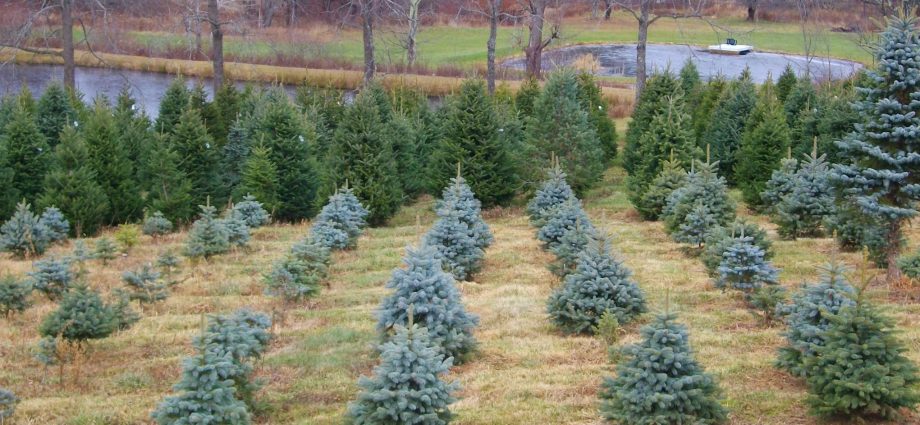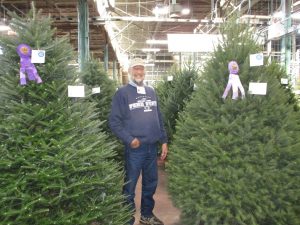Jim Kessler, owner of Kessler’s Tree Farm, stands between two Grand Champion Christmas trees in the Pennsylvania Christmas Tree Growers Association at the 107th Pennsylvania Farm Show in Harrisburg.
Story and photos by Rick Hiduk
(Originally published in the Susquehanna County Independent)
The Pennsylvania Christmas Tree Growers Association (PCTGA) was well-represented at the Pennsylvania Farm Show on Monday with Jim Kessler of Kessler’s Tree Farm in Franklin Township, Susquehanna County. He bought a former dairy farm in an area between Franklin Hill and Milkcan Corners in 1977, built his home there in 1978, and started growing trees the next year. He was a forester with the DCNR Bureau of Forestry from 1979 to 2009, when he retired and put all of his industry into his own growing operation.
The “Christmas Tree Capital” of Pennsylvania is contested tongue-in-cheek among PCTGA members, but Kessler puts Susquehanna County at the head of the pack because its cooler climate is more consistent than other counties. In 2022, a tree was chosen from Shealer’s Evergreen Acres in Auburn Township as the official Christmas Tree for the White House. The Douglas fir grown by Paul and Sharon Shealer first won the National Christmas Tree Association’s National Tree and Wreath Contest.
Nonetheless, 2022 was a tough growing year. The weather was too wet from the start and then hot and dry for a few months, which was hard on seedlings. The rains finally came back toward the middle of August and saved most of the crop.
Kessler has monitored Mother Nature’s mood swings for more that 40 years now, which gives him insight into which varieties might be his cash crop from one year to the next. He is not alone, however.
“We have a real strong association,” Kessler said of the PCTGA. “If one person learns a trick, they share it with the others.” One of Kesslers tricks is to plant trees on a hillside to allow for better drainage. “So, we have a pretty high-value product compared to 50 years ago.”
Kessler’s decades of research and experience allows him to easily explain in layman’s terms something as complex as the geological history of evergreens and how different species of trees evolved after they were pushed south by glaciers. As the glaciers retreated and the weather warmed, some trees simply followed the glaciers back to their origins. Some climbed the hillsides into cooler air to survive, and some found a way to acclimate to the changes and morph into variations or subspecies.
One example that he cited to guests at the PCTGA exhibit was the Frazier fir, which was pushed down into the future Carolinas during the Ice Age. As the ice melted, some Fraziers survived there at higher elevations. But some of them moved up the Canaan Valley in future West Virginia and became the Canaan fir tree.
“Is it really a subspecies or just a tree that acclimated itself to a new climate?” he pondered aloud – like humans can live in Alaska or Florida, but they are still humans.
Climate is not the only challenge for Christmas tree growers, especially in the current economy. Fertilizer that averaged $200 to $300 a few years ago now runs over $1,000 annually and weed control has also tripled in cost. Nonetheless, with the knowledge and experiences of evergreen grower associations across the country, he said, “We can grow a better quality tree, and adapt to the soil conditions. But we still haven’t conquered the deer problem.”
As little children played among the PCTGA display in the Main Exhibit Hall as if it were an enchanted forest, Kessler divulged some of the methodology of why it looks so beautiful from the entrance. When the participants bring in their entries, they are first lined up by species. They are judged by the public during the opening weekend and rearranged before the Farm Show opens again on Monday morning so that all of the first-place trees are positioned across the front, followed by second-, third-place, etc. of varying species. Two grand champions stand proudly behind the information table.
People might be surprised at the level of interest Farm Show guests show in the trees beyond their aesthetic beauty. A teenage boy approached Kessler and asked what he used to trim the trees and when. The answer: a tree knife, which can be used like a light-weight machete, or – on breezy days – sheers. And the hardest trim occurs in the summer. As soon as he left, an older man asked Kessler when he realizes a profit.
“You work on these trees for 11 months, and then their gone,” the man remarked.
“You’re right,” Kessler replied. The trees are cut Thanksgiving week and shipped to retailers. “Pay day is one week long. I was done this year on Dec. 3.”
Kessler also replied to comments from guests that some types of evergreens – such as white pines – are difficult to decorate or don’t look as nice as others. His response was that every tree can be beautiful if decorated correctly.
When asked about the future of the Christmas tree industry, Kessler remains positive. “Going forward, things look good,” he said, noting that the competition now is between tree farmers and those who sell artificial trees. “But, as long as there is Christmas, people will always want Christmas trees.”

